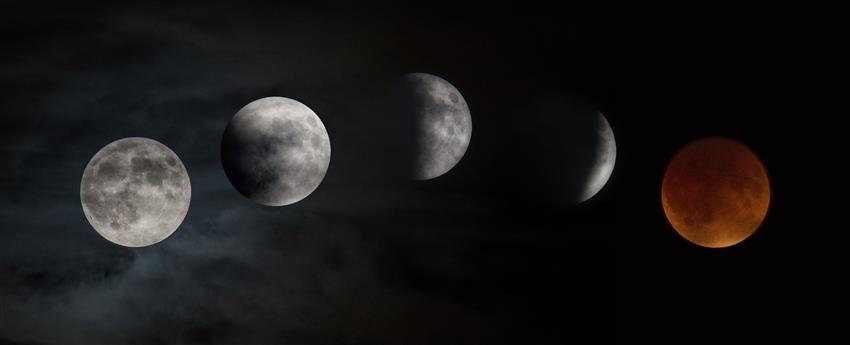Learning about eclipses
Let's learn about a spectacular phenomenon called an eclipse. There are two types of eclipses, and we will explore each type separately. Make sure you use the following settings to get started exploring eclipses.
- Expand the Look At drop-down menu at the bottom left side of the screen. Select the SolarSystem mode.
- From the list of objects displayed at the bottom of your screen, click the Earth icon.
- Click
 . Check the Planetary Orbits box to activate it. Zoom out until you can see lots of lines in different colours. These lines are the orbits of the planets and the Moon.
. Check the Planetary Orbits box to activate it. Zoom out until you can see lots of lines in different colours. These lines are the orbits of the planets and the Moon. - Drag your cursor down until you can see the Moon's entire orbit from above.

WorldWide Telescope screenshot shows a second view of the Moon orbiting Earth (View menu, Earth option).
The Moon orbiting Earth. (Credit: Screenshot from WorldWide Telescope)
Solar eclipses
The solar eclipse is the most amazing lunar phenomenon seen from Earth. This type of eclipse happens when Earth, the Moon and the Sun are all aligned. The image below shows what your screen should look like if you turn off the shadow setting right before the eclipse. If you feel confident using the application, you can try following this step without turning off shadows. Now it's your turn to try and recreate a solar eclipse using what you've learned about WorldWide Telescope.
- Look at the image below. What order are Earth, the Moon and the Sun lined up in?
- What is the Moon's phase during a solar eclipse?
- To see a realistic view of a solar eclipse, Earth and the Moon must be displayed at their actual sizes.
- Use the following start date and time:
- Move around Earth to recreate the image below on your screen.
- Activate the shadows. Fast forward the speed of time by × 100.
- Watch the eclipse closely to see if it becomes a total eclipse (if the Moon completely covers the Sun). If not, rewind back in time to the starting point. Change your alignment and try again.
- You may have trouble lining everything up perfectly, which is one of the reasons why we don't see eclipses every month.

WorldWide Telescope screenshot shows a solar eclipse (View menu , Earth option).
A solar eclipse. (Credit: Screenshot from WorldWide Telescope)
Lunar eclipses
In this section, you will learn about lunar eclipses, which happen when the Sun, Earth and the Moon are perfectly aligned. The Windows version of WorldWide Telescope very clearly shows the shadows of an eclipse. Unfortunately, the Web client for the telescope does not show them very clearly. You cannot see the Moon getting darker during the lunar eclipse. Instead, you can watch the eclipse as though you were an astronaut on the Moon.
- Open the View menu. Click the date and time panel.
- In the pop-up window that appears, enter the following information:
- Date:
- Time: 4 hours, 45 minutes, 0 seconds
- Check the UTC box
- Click OK. The view on the screen should change because of this new date.
- From the list of objects at the bottom of your screen, click the Moon icon.
- Try to change your view so you can also see Earth on your screen. You will have trouble seeing Earth because you are looking at its dark side. Earth will appear almost completely black.
- If you aren't able to find Earth, click
 and uncheck the Lighting And Shadows checkbox. The Moon and Earth are now lit up, as shown in the image below, and are therefore easier to see.
and uncheck the Lighting And Shadows checkbox. The Moon and Earth are now lit up, as shown in the image below, and are therefore easier to see. - What order do the Moon, Sun and Earth have to be lined up in to create a lunar eclipse?
- If you aren't able to find Earth, click
- Zoom in closer to the Moon so that Earth and the Sun are beside it, and so that you are very close to the Moon.
- Shift your view so that it looks like the image below with Earth to the right of the Sun.
- If you had turned off the shadow setting, turn it back on to watch a realistic eclipse.
- Now it's time to watch the eclipse as if you were on the Moon.
- If a person on Earth is able to watch a lunar eclipse, what kind of eclipse would you watch from the Moon?
- Bit by bit, fast forward to × 100 to enjoy the solar eclipse that is about to begin.
- Would you want to be on the Moon to see a real solar eclipse like this? It would be more impressive than watching a lunar eclipse from Earth.

WorldWide Telescope screenshot shows a lunar eclipse (View menu, Moon option, uncheck Lighting And Shadows checkbox).
A lunar eclipse. (Credit: Screenshot from WorldWide Telescope)

